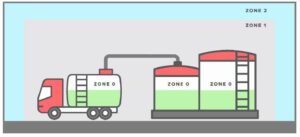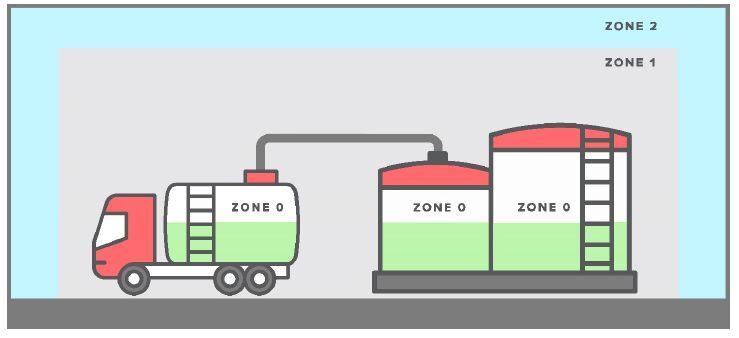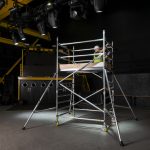ATEX is an acronym for “Atmospheres Explosives” and generally refers to a set of European Union (EU) directives for the design of electrical equipment suitable for use in hazardous locations where an explosive atmosphere could exist. Typical hazardous locations include the more obvious places such as flour mills, coal mines, petrochemical plants, fuel transfer facilities etc. However, some not so obvious hazardous locations also include waste water treatment plants, saw mills, tunnels and underground passageways or any location where a build-up of naturally occurring flammable material (such as methane or dust) could arise.
In many of these locations there is a need for condition monitoring, for example by measuring parameters such as temperature or vibration on rotating machinery. The equipment needed to do the monitoring in these hazardous location must therefore be “safe” to use, in other words it must be incapable of igniting an explosive atmosphere, should one exist. This is where ATEX comes in, as in order to be considered “safe”, equipment needs to be certified as safe for use in hazardous locations. The certification of compliance with a directive such as ATEX is usually carried out by private companies that have been approved to act as certifying bodies.
As previously mentioned, the ATEX directives cover the EU and hence if an item of equipment, such as a handheld instrument, is certified as being compliant with ATEX it can be assumed “safe” to use in hazardous locations anywhere within the EU. At international level the relevant directives are specified by the International Electrotechnical Commission (IEC) and the IECEx directives apply worldwide. In many countries throughout the world equipment that complies with IECEx is generally accepted for use in hazardous locations but in some areas local compliance is also required. For example, ATEX is required in the EU, while in North America (USA and Canada) certification by an approved North American certifying body is also required. IECEx and ATEX are in fact quite similar with a good deal of overlap but, as will be explained later, the North American system of classification of hazardous locations is slightly different.
How can equipment be guaranteed “safe” for use in hazardous locations?
There are many ways of ensuring that an electrical instrument is incapable of igniting an explosive atmosphere. These include encapsulation, oil immersion, pressurisation etc. but the most practical method for something like a handheld meter is the use of “intrinsic safety”, whereby the instrument is designed in such a way that it cannot produce a spark or become sufficiently hot to ignite gas. This is usually achieved through the inclusion of power limiting components within the instrument. Intrinsic safety is generally the preferred method for handheld devices due to the fact that it is not easy to encapsulate things like keypads, sensor connections, battery compartments etc. to a sufficiently high level of encapsulation. But even if that were possible, there would still be the necessity to limit the instrument’s surface temperature in the case of an internal instrument fault for example, and hence a need for it to be designed as intrinsically safe.
There are different levels of intrinsic safety, depending on the number of equipment faults that can be tolerated while still maintaining safety. As explained later, the concept of intrinsic safety is based on a combination of the likelihood of an explosive atmosphere existing, together with the likelihood of the equipment developing a fault. Basically, the more likely that an explosive atmosphere could exist, the more possible equipment faults that need to be tolerated. Typically, to guarantee an instrument is intrinsically safe, maximum power levels are deliberately limited inside the instrument using fuses, resistors, Zener diodes etc. So that the equipment remains safe in the presence of faults in any of these power limiting components, it is necessary to design in an appropriate level of redundancy. Hence the more fault tolerant the equipment, the more redundancy is required, which
What is ATEX and why is it important? TPI Europe August 2021
inevitably increases the complexity and subsequent cost of the instrument. Additionally, the cost of having an item of equipment certified intrinsically safe by a certifying body is certainly not cheap, typically running into several tens of thousands of dollars, and again as explained later, this cost may need to be repeated a few times over if an instrument is to be certified for use in different geographical regions (e.g. if it requires IECEx, ATEX and North American certification). The certification cost consequently needs to be amortised over the number of instruments sold and unless a high enough number of instruments can be guaranteed to be sold this can significantly add to the cost of intrinsically safe devices.
Definitions of areas subject to explosive atmospheres
As previously mentioned, the concept of intrinsic safety is based on a combination of the likelihood of an explosive atmosphere existing, together with the likelihood of the equipment developing a fault. The likelihood of an explosive atmosphere existing is generally dealt with by the definition of various zones, and for IECEx (Worldwide) & ATEX (Europe) the following zones are defined:
Zone 0 – an area in which an explosive atmosphere is present constantly or for long periods or frequently.
Zone 1 – an area in which an explosive atmosphere is likely to occur in normal operation occasionally.
Zone 2 – an area in which an explosive atmosphere is not likely to occur in normal operation but, if it does occur, will persist for a short period only.
The diagram in Figure 1 below illustrates an example of these various zones such as might be encountered in a fuel transfer operation, where Zone 1 arises during the “normal operation” of transferring fuel. This is why, for example, a petrol (gas) filling station would normally be closed to other vehicles whilst a tanker is discharging into fuel tanks and the possibility of an explosive atmosphere could arise.
 Figure 1 – examples of IECEx and ATEX zones
Figure 1 – examples of IECEx and ATEX zones
What is ATEX and why is it important? TPI Europe August 2021
In contrast to IECEx and ATEX, the North American Class/Division System considers only two possible likelihoods of explosive atmospheres occurring:
Class 1, Division 1 – a mixture of flammable gas, dust or vapor occurs permanently or occasionally (effectively the combination of Zone 0 and Zone 1).
Class 1, Division 2 – explosive mixtures occur only rarely and for a short amount of time (the same as Zone 2).
There is however a new classification of Class 1, Zone 1 that is starting to come into use in North America (USA and Canada) that directly equates to IECEx/ATEX Zone 1.
In order to operate in each of these various zones, intrinsically safe equipment (e.g. instruments) need to be able to demonstrate different levels of fault tolerance. For example, to operate within Zone 2 an intrinsically safe instrument needs only to be safe in normal operation, in other words as long as it has zero faults. In order to operate in Zone 0 however, an intrinsically safe instrument must continue to be safe even in the presence of up to two faults. This implies not only a high level of redundancy in terms of the safety components, e.g. triplication, but also careful design and layout of the safety circuits themselves.

Table 1 – Different levels of Intrinsic Safety Ex protection covering different zones





